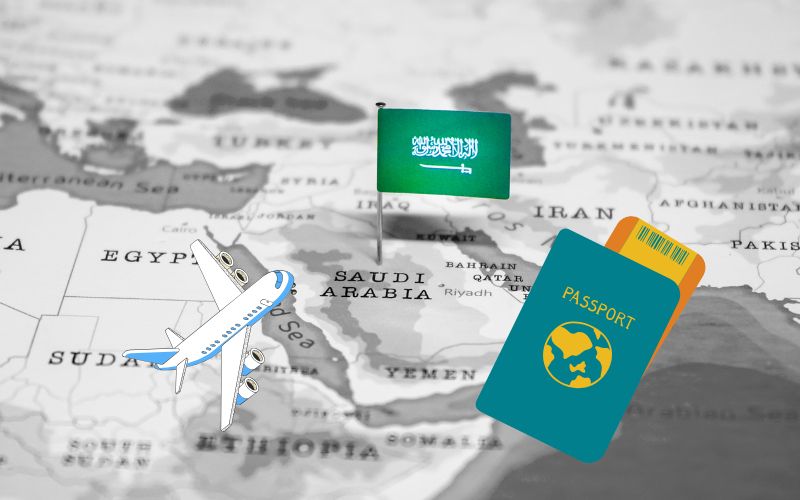Visiting Saudi Arabia is now easier than ever. It is a country with a rich cultural heritage and significant religious significance, and has increasingly opened its doors to the world, inviting travelers, business professionals, and pilgrims. Many first-timers look for a short visit for leisure, business, or religious purposes, so it is important to understand the details of obtaining short-term Saudi visas is essential.
Read this guide to get a detailed look into the types of short-term visas available, the application process, requirements, and tips to ensure a smooth experience.
A. Types of Short-Term Saudi Visas
Saudi Arabia offers various types of short-term visas tailored to the needs of different travelers. The most common ones include:
- Tourist Visa: Introduced in 2019, the Saudi tourist visa from Dubai allows travelers to explore Saudi Arabia for leisure. This visa can be single-entry or multiple-entry, with a stay duration of up to 90 days within 12 months. Now Saudi Arabia has launched evisa in several other countries.
- Business Visa: It is ideal for professionals attending meetings, conferences, or business-related activities. This visa typically allows for a stay of 30 to 90 days, depending on the purpose of the visit.
- Umrah Visa: Designed for Muslims wishing to perform Umrah, a pilgrimage that can be undertaken at any time of the year, unlike Hajj. The Umrah visa is usually valid for 30 days.
- Family Visit Visa: Those visiting close relatives residing in Saudi Arabia should apply for a family visit visa. The duration of stay under this visa can range from 30 days to 90 days.
- Transit Visa: If you’re passing through Saudi Arabia on your way to another destination, you may need a Saudi transit visa. This visa usually allows for a short stay of up to 96 hours.
B. Eligibility Criteria of Short-Term Saudi Visas
Each type of short-term visa has specific eligibility criteria. Here’s a general overview:
- Tourist Visa: It is open to citizens of eligible countries, including the United States, United Kingdom, Schengen Area, and several Asian countries. Applicants must have a valid passport, travel insurance, and, in some cases, proof of accommodation and return travel.
- Business Visa: To get the business visa, the applicant requires a letter of invitation from a Saudi company, proof of business activities, and a valid passport. Some nationalities may need a sponsor in Saudi Arabia.
- Umrah Visa: Applicants must be Muslims, have a valid passport, and, if applicable, a Mahram (male guardian) for female travelers under 45 years old.
- Family Visit Visa: For a family visit visa, you require an invitation from a family member residing in Saudi Arabia, proof of relationship, and a valid passport.
- Transit Visa: This visa is available to travelers who need to stop in Saudi Arabia en route to another country. For this, a valid onward ticket and passport are required.

C. Application Process for Short-Term Saudi Visas
The application process for a short-term Saudi visa varies depending on the type of visa and the applicant’s nationality. Here’s a step-by-step guide:
Step 1: Understand Your Visa Type
Before applying, identify the correct visa type based on your purpose of travel. Ensure that you meet the eligibility criteria for that specific visa.
Step 2: Sort and Submit Required Documents
Depending on the visa type, you’ll need to gather various documents. Common requirements include:
- A valid passport with at least six months’ validity.
- Recent passport-sized photographs.
- Proof of accommodation (hotel booking or invitation letter).
- Return or onward travel ticket.
- Travel insurance covers the duration of stay.
- Supporting documents specific to the visa type (e.g., business invitation letter, Umrah pilgrimage documents).
Step 3: Apply Online or Through a Visa Agency
Saudi Arabia offers an eVisa service for tourist visas, making the application process straightforward and quick. You may need to apply through a visa agency or at a Saudi consulate or embassy for other visa types.
- For Tourist Visas: Visit the official Saudi eVisa portal, fill out the application form, upload the required documents, and pay the visa fee. Once approved, the eVisa will be emailed to you.
- For Other Visas: Submit your application through an accredited visa agency or a Saudi consulate. Ensure all documents are complete and accurate to avoid delays.
Step 4: Pay the Visa Fee
The visa fee varies depending on the visa type and processing time. Payment can typically be made online or at the consulate.
Step 5: Wait for Visa Approval
Saudi visa processing time can range from a few hours (for eVisas) to several days or weeks, depending on the visa type and your nationality. Once approved, you’ll receive your visa either electronically or stamped in your passport.
D. Key Considerations and Tips for Short-Term Saudi Visas
To avoid any last-minute delays, here are the best tips for Saudi Visa:
- Plan Ahead: Start your visa application process well in advance of your intended travel date to account for potential delays.
- Ensure Document Accuracy: Double-check all documents for accuracy. Incomplete or incorrect information can lead to delays or visa denial.
- Understand Visa Conditions: Be aware of the conditions tied to your visa, such as the maximum stay duration and entry restrictions. Overstaying or violating visa terms can result in fines or a ban on future travel to Saudi Arabia.
- Stay Informed: Saudi visa regulations can change, so it’s important to stay updated on the latest requirements. The Saudi Ministry of Foreign Affairs website is a reliable source of up-to-date information.
5. Common Challenges for Short-Term Saudi Visas
Obtaining a short-term Saudi visa is generally straightforward, but applicants may face certain challenges:
- Lengthy Processing Times: Some visas, especially those requiring a sponsor or invitation, can take longer to process. Apply early to avoid last-minute stress.
- Document Issues: Missing or incorrect documents can delay the visa approval process. Carefully review the document checklist provided by the consulate or visa agency.
- Visa Rejection: In rare cases, when you check Saudi visa status, it may be rejected due to incomplete applications, prior violations of Saudi laws, or security concerns. If your visa is denied, you may appeal the decision or reapply with corrected information. To avoid such situations, know about the reasons for Saudi visa rejection.

E. What to Do Next
Once your short-term Saudi visa is approved, there are a few steps to take before your trip:
- Verify Visa Details: Check the visa for any errors, such as incorrect names, passport numbers, or visa validity dates. Contact the consulate or visa agency immediately if you spot any mistakes.
- Prepare for Entry Requirements: Familiarize yourself with Saudi Arabia’s entry requirements, including customs regulations, COVID-19 protocols, and restrictions on certain items.
- Plan Your Itinerary: Whether you’re visiting for business, leisure, or pilgrimage, planning your itinerary in advance will help you make the most of your stay in Saudi Arabia.
7. Conclusion
Navigating the process of obtaining a short-term Saudi visa can seem daunting, but with the right information and preparation, it becomes a manageable task. Understanding the different types of visas, meeting the eligibility criteria, and following the application steps will ensure a smooth experience. Whether you’re visiting for tourism, business, or religious purposes, Saudi Arabia offers a unique and enriching experience that’s well worth the effort of securing a visa.

A travel influencer, adventurer and blogger on a mision to dicover the hidden gems of this beautiful planet. For me traveling isn’t a hobby, but a way of living.



